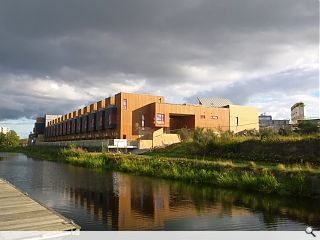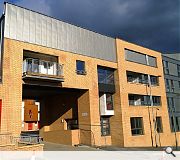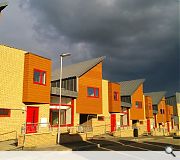Maryhill Locks ‘urban village’ takes shape
August 20 2014
Work to deliver 125 new homes at Maryhill Locks, Glasgow, is continuing apace with the unveil of a £16m second phase of a long term master plan for the area by Maryhill Housing Association.Designed by Hypostyle the £16m project sits on 18 hectares of brownfield land and incorporates a range of shared equity and rental properties alongside a commercial unit.
Taking the form of terraced housing, cottage flats and flats the build is intended to usher in a contemporary ‘urban village’ including 800 homes, shops, cafes, business and community space upon completion.
Maryhill Locks is one of 11 projects to be granted Scottish Sustainable Community status by the Scottish government, described as ‘…creating places which are ambitious and inspiring, and which raise standards in design, architecture and sustainable construction…’
.
Phase one of the project was delivered by Elder & Cannon in 2011. There are also separate plans to build a new health centre at Gairbraid Avenue.
|
|
11 Comments
#1 Posted by Ellah on 20 Aug 2014 at 21:46 PM
Hmm.. Certainly reflects industrial units that would have lined the canal... Not particularly residential in character, certainly not a village or worthy of the setting. Why can no one in glasgow design a decent background building? It's not like there's no precedent, tenements make glasgow and are simple consistent buildings tha give both identity and structure. New gorbals is the only one that will stand tge test of time.Bit gutted as it looked good in the drawings.
#2 Posted by A McEwan on 21 Aug 2014 at 13:27 PM
I have to say this is astonishingly poor, especially regarding the potential of the site to cultivate an interesting mix of forms and house typologies as displayed previously by E&C and hopefully in the future by NORD.
It really highlights the paucity of both talented architects within the social housing sector and engaged, experienced clients who value design and the built environment as well as their tenants.
The recent completion of the New Gorbals Housing Association's Laurieston scheme shows that high quality social housing is eminently deliverable. Unfortunately the custodians of our built environment and public money are by and large unambitious Housing Associations, who wouldn't know quality architecture if they passed it on the street. Thankfully there are exceptions to this!
Its heartbreaking to see Glasgow littered with this trash on a frequent basis.
It really highlights the paucity of both talented architects within the social housing sector and engaged, experienced clients who value design and the built environment as well as their tenants.
The recent completion of the New Gorbals Housing Association's Laurieston scheme shows that high quality social housing is eminently deliverable. Unfortunately the custodians of our built environment and public money are by and large unambitious Housing Associations, who wouldn't know quality architecture if they passed it on the street. Thankfully there are exceptions to this!
Its heartbreaking to see Glasgow littered with this trash on a frequent basis.
#3 Posted by Art Vandelay on 21 Aug 2014 at 16:35 PM
#2 - I completely agree with you regarding the quality of the architecture, but I wouldn't necessarily place equal blame on the architects in the social housing sector. More of an issue is the lack of forward thinking, ambitious RSLs who have an aspiration to use exemplar design as a driver for true regeneration. Too often, any aspirations from the designers at the outset of a project are diluted by a variety of factors - stemming from a reluctance on the part of HAs (and their contractors) to deviate from typologies and design principles that have been rolled out on countless sites previously. The result is that we now have a strand of architecture - the provision of public housing - that has stagnated for much of the past 20 years. There are exceptions (Laurieston being a good example, some of Collective's work for various clients too), but on the whole you could distil most 'social' housing into one dual pitched, buff facing-bricked morass. It's especially galling when you consider the role of housing as a kind of test bed for socially aware, response community architecture.
#4 Posted by NC on 21 Aug 2014 at 17:02 PM
Is this actually inspired by industrial units? If so, WHY???...and the architect's interpretation seems a bit too literal! The massing is cumbersome and the material and colour palette leaves a lot to be desired. It's easy to criticise...but this is very easy to criticise. I hope the plan and organisation absolutely ingenious to compensate!
#5 Posted by Charlie_ on 21 Aug 2014 at 18:55 PM
I've felt like the UR pictures on a couple of recent builds have been unflattering; these aren't - it's even worse in person. Toe curlingly bad.
#6 Posted by Tom Manley on 22 Aug 2014 at 10:38 AM
these comments are in a response to poor photographs that to be fair do no credit to this project. there is a variety of massing and arrangement of house types which is interesting. Walking along the canal front quite often I've been watching the elevation along the waterfront take shape ( which is not finished in these photos or represented clearly.) It looks quite sharp and well detailed and a good response to the waterside and nearby housing context .. theres a lot going on here with some curious material choices and design decisions but not worthy of this criticism based on poor photos that do nothing for this project. As a photographer, its worth stressing the importance of getting good images - that could easily garner more positive responses here and give a better overview of the project.
#7 Posted by Art Vandelay on 22 Aug 2014 at 11:05 AM
I don't even think Cartier-Bresson could make those red windows look good...
#8 Posted by Gringo on 22 Aug 2014 at 14:02 PM
Jesus Christ- Image 2 looks like someone ate a big book of housing typologies and then shat out every architectural device ever invented on the same page.... what a shambles.....
#9 Posted by Chris on 22 Aug 2014 at 16:46 PM
#6 - The comments are not in response to poor photographs, they are mainly in response to a very poor development. The canal-side buildings are the pick of the bunch, if you leave the path and look behind them then you will see the real dross.
And why is everything an "urban village" these days? What does that even mean?
And why is everything an "urban village" these days? What does that even mean?
#10 Posted by Artisan2 on 22 Aug 2014 at 16:54 PM
Inspired by industrial units? Is that a negative observation?
Communities will become stronger and more resilient when/if their designers include diverse, affordable workspace in their midst. A canal frontage could be a great location for some 21st century light industry. Manufacturing at home in the pre-industrial era used to be known as 'cottage-industry'. In this post-industrial age, we should respect that tradition, not banish artisans to 'industrial estates'. Our cities have been allowed to dis-integrate, the product of a continuing segregation-mindset among planners and the narrowly-motivated ambitions of developers, private and public.
We get the 'communities' we allow ourselves to be fobbed off with.
Communities will become stronger and more resilient when/if their designers include diverse, affordable workspace in their midst. A canal frontage could be a great location for some 21st century light industry. Manufacturing at home in the pre-industrial era used to be known as 'cottage-industry'. In this post-industrial age, we should respect that tradition, not banish artisans to 'industrial estates'. Our cities have been allowed to dis-integrate, the product of a continuing segregation-mindset among planners and the narrowly-motivated ambitions of developers, private and public.
We get the 'communities' we allow ourselves to be fobbed off with.
#11 Posted by IM on 22 Aug 2014 at 17:41 PM
Disappointing considering the quality of the original master plan.
Post your comments
Read previous: Paisley pupils begin lessons at £15.9m St James’ Primary
Back to August 2014
Like us on Facebook
Become a fan and share
News Archive
Search News
Features & Reports
For more information from the industry visit our Features & Reports section.





